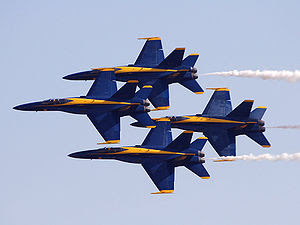 The United States Navy's Navy Flight Demonstration Squadron, popularly known as the Blue Angels, first performed in 1946[1] and was the world's first officially sanctioned military aerial demonstration team.[citation needed] The squadron's six demonstration pilots fly the Boeing F/A-18 Hornet in more than 70 shows at 34 locations throughout the United States each year, where they still employ many of the same practices and techniques used in their aerial displays in 1946. Since their inception, the "Blues" have flown a variety of different aircraft types for more than 427 million spectators worldwide.
The United States Navy's Navy Flight Demonstration Squadron, popularly known as the Blue Angels, first performed in 1946[1] and was the world's first officially sanctioned military aerial demonstration team.[citation needed] The squadron's six demonstration pilots fly the Boeing F/A-18 Hornet in more than 70 shows at 34 locations throughout the United States each year, where they still employ many of the same practices and techniques used in their aerial displays in 1946. Since their inception, the "Blues" have flown a variety of different aircraft types for more than 427 million spectators worldwide.
Mission:
The mission of the Blue Angels is to enhance Navy recruiting, and credibly represent Navy and Marine Corps aviation to the United States and its Armed Forces to America and other countries as international ambassadors of good will.
Air show overview:
The Blue Angels show season runs each year from March until November. They perform at military and civilian airfields, and often perform directly over major cities such as San Francisco and Seattle during "Fleet Week" maritime festivals.
During the aerobatic demonstration, the Blue Angels operate six FA-18 Hornet aircraft, split into the Diamond (Blue Angels 1 through 4) and the Lead and Opposing Solos (Blue Angels 5 and 6). Most of the show alternates between maneuvers performed by the Diamond and those performed by the Solos. The Diamond, in tight formation and usually at lower speeds, performs maneuvers such as formation loops, barrel rolls, and transitions from one formation to another. The Solos fly many of their maneuvers just under the speed of sound, showcasing the high performance capabilities of their individual Hornets through the execution of high-speed passes, slow passes, fast rolls, slow rolls, and very tight turns. Some of the maneuvers include both solo F/A-18s performing at once, such as opposing passes (toward each other in what appears to be a collision course) and mirror formations (back-to-back. belly-to-belly, or wingtip-to-wingtip, with one jet flying inverted). The Solos join the Diamond near the end of the show for a number of maneuvers in the Delta formation.
The parameters of each show must be tailored to local weather: in clear weather the "high" show is performed; in overcast conditions a "low" show is performed, and in limited visibility (weather permitting) the "flat" show is presented. The "high" show requires an 8,000-foot (2,400 m) ceiling and visibility of 3 nautical miles (6 km) from the show's centerpoint. "Low" and "flat" ceilings are 3,500 and 1,500 feet (460 m) respectively.


0 comments:
Post a Comment